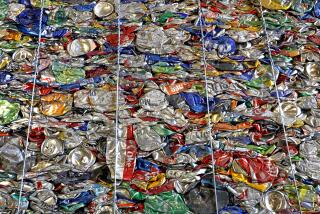Trash Trackers
- Share via
VENTURA — The men in papery white Tyvex suits don their gloves and put on their fuzzy respirators.
With a smelly rumble, 200 pounds of trash and a cloud of fumes pour from a giant brown garbage can onto a wooden table--and the men’s hands fly.
They sort the refuse and pitch it into one of 56 labeled garbage cans.
Leaves into the trimming barrel, discarded business letters into the white ledger paper barrel. Wait.
What’s this strange, unidentifiable white powder from an optometrist’s office?
The flying hands pause. A discussion follows. Aha. Glass shavings. Into the glass container it goes.
These white-suited men are professional trash-sorters, and the city of Ventura is paying them $96,000 to wade through hundreds of thousands of pounds of trash in coming weeks to determine the composition of the city’s waste.
Ventura is the first community to use the state’s new uniform waste characterization method to determine who generates what type of trash and how much.
That data will be used to tune recycling efforts more finely, says Ray Olson, Ventura’s waste management specialist.
Ultimately, the information will be used to help the city cut municipal waste in half by 2000, as required by state law. Currently, about 42% of the city’s 191,000 tons of solid waste is being diverted from landfill disposal through waste reduction and recycling programs.
The study is being conducted using methods developed by experts from the University of California and the California Integrated Waste Management Board. The study will be carried out largely by workers from Long Beach-based SCS Engineers.
But the project has broader implications.
The U.S. Environmental Protection Agency will be watching from the sidelines to decide whether California’s sorting method should be adopted nationwide.
“Ventura is the first city to use this,” Olson said. “We are really on the tip of the cutting edge here.”
To date, workers have sorted more than 30,000 pounds of Ventura’s trash into 56 categories ranging from phone books to manure. Trash samples weighing up to 200 pounds individually and 3,000 pounds daily are collected from Ventura businesses and homes.
California’s so-called uniform method requires materials to be divided into eight major categories of paper, plastic, glass, metal, construction and demolition debris, household hazardous waste, organic waste and special waste.
Those categories are then divided into 56 sub-categories. Paper, for instance, has 11 sub-categories ranging from cardboard to computer paper.
Organic waste is divided into eight sub-categories ranging from stumps to food.
Trash is split into residential and business samples.
The commercial categories are divided into 19 groups that include hotels, restaurants, medical offices and toy manufacturers.
Olson said sorting has already revealed surprises; one early sort showed about 40% of waste from auto centers is landscape debris.
That information, he said, will allow the city to target a huge amount of waste for recycling that normally would have ended up in a landfill.
Similarly, medical offices appear to use large quantities of white ledger paper. If true, the city can work harder to get medical offices to recycle their paper.
Sorting will also be done at different times of year to help the city determine how waste changes with the seasons. During the tourist season, for instance, waste generated by hotels and restaurants will be more carefully analyzed.
As they pick and sort, the men talk trash.
“Pretty much anything humans can make waste of, we’ve seen,” sorter Dean Camero said. “It’s pretty lively.”
Last week they found a rat in a trap. The trap went into the lumber barrel. The rat into the “remainder composite special waste” barrel.
Beyond direct recycling, sorting trash also offers interesting insights into American culture, sorters say.
“Most people take their junk mail and tear it in half,” Olson said. “What does that mean? And no one eats the ends of their bread.”
Trash sorter John Ekhoff sees more sobering patterns.
“Everyone throws food away. People don’t eat what they buy. We really waste food like crazy.” He said fast-food restaurants are the worst, throwing out food and generating reams of Styrofoam and paper wrappings.
“We are not living sustainably,” he said. “At this rate we can only last a few more decades.”
Camero says that although recycling helps, in the end the burden of reducing waste rests with each resident.
“There are so many things that can’t be recycled,” he said, holding up a waxy piece of paper as an example. “The responsibility really goes back to the consumer to buy simpler packaging. There needs to be a way to motivate people to purchase differently.”
More to Read
Sign up for Essential California
The most important California stories and recommendations in your inbox every morning.
You may occasionally receive promotional content from the Los Angeles Times.










